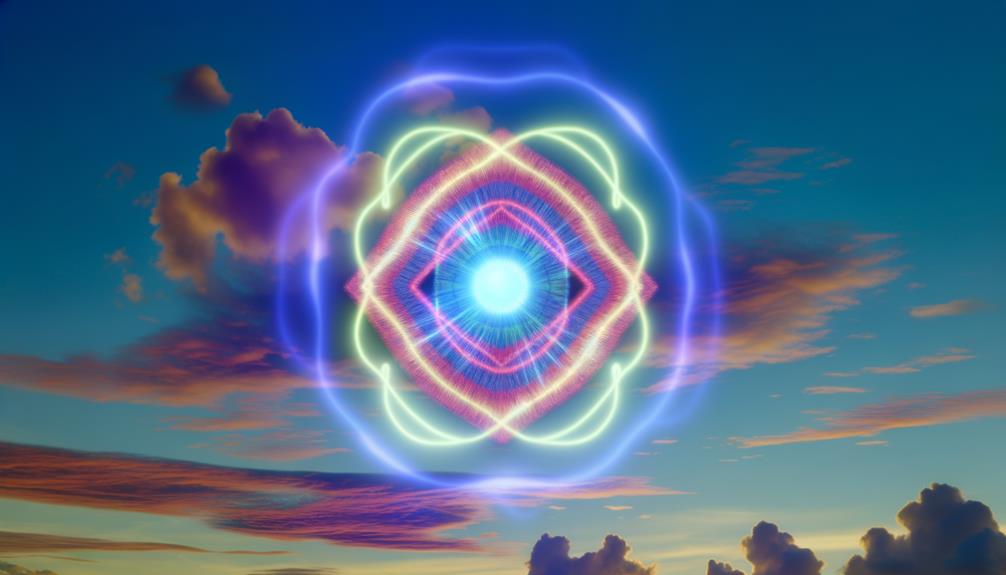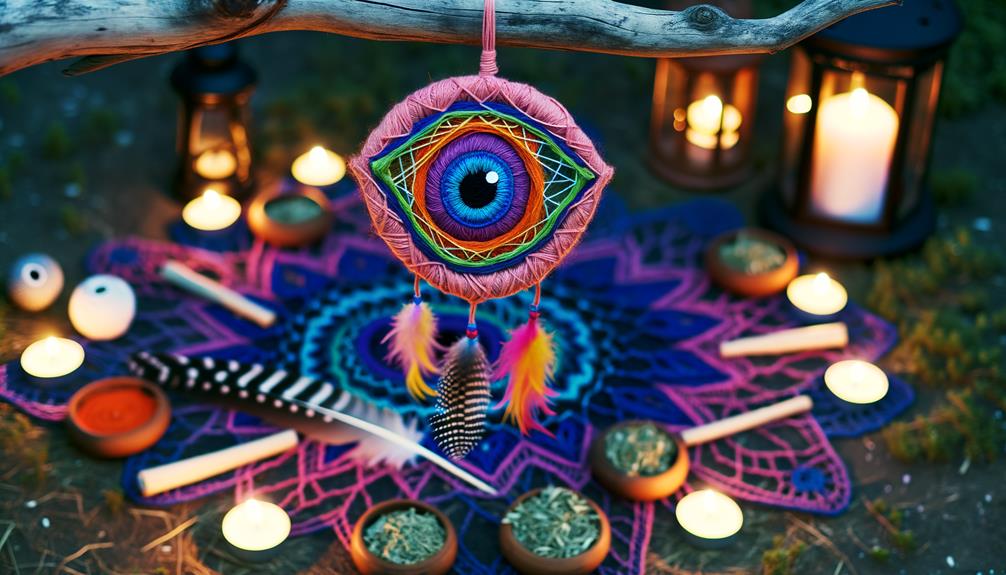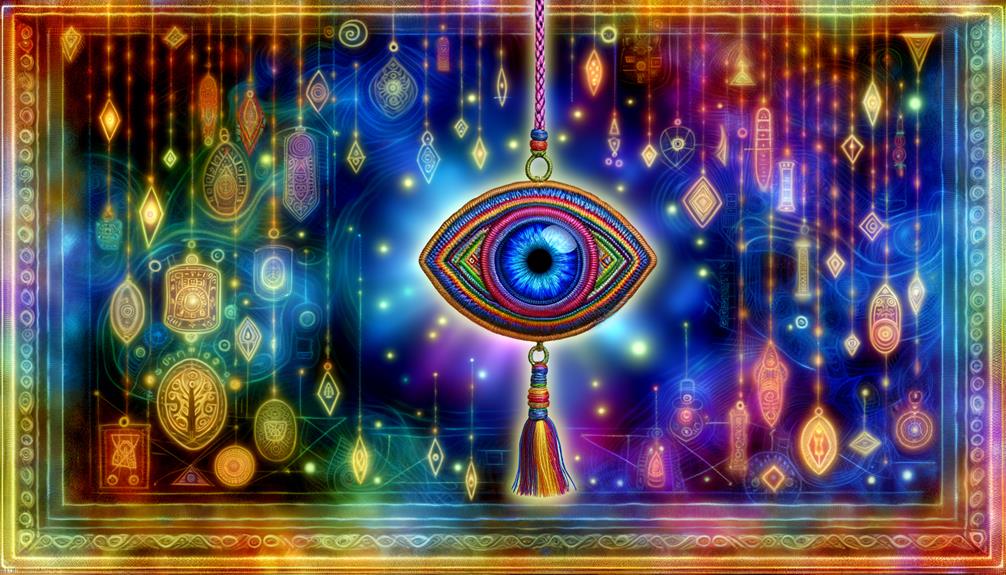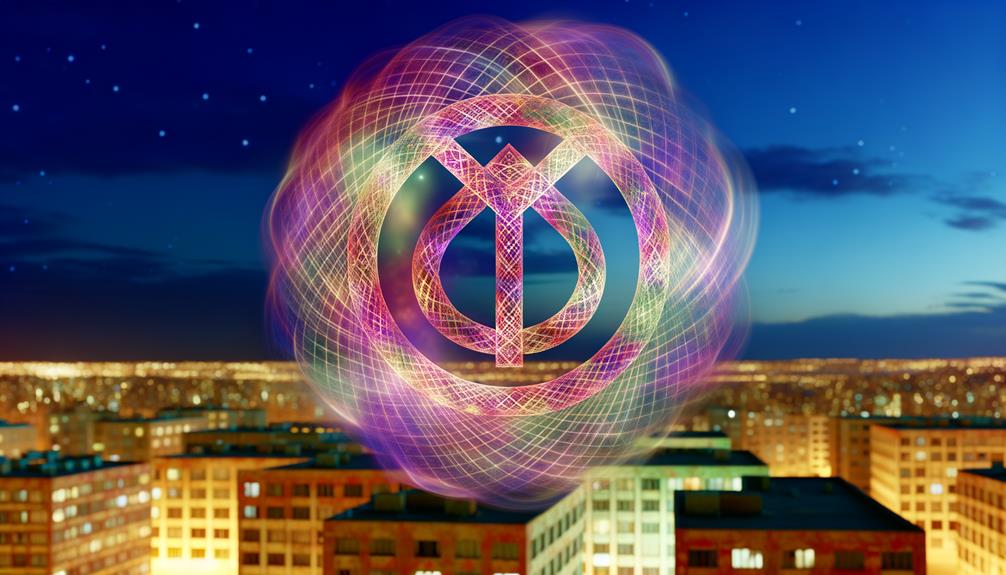God’s Eye Spiritual Meaning: Divine Watchfulness
The God’s Eye, or ‘Ojo de Dios,’ is a spiritually significant object originating from the indigenous Huichol and Tepehuan people of western Mexico. Created using sticks and colorful yarn, it symbolizes divine protection and the ability to see and understand the unknown.
This sacred artifact is deeply embedded in rituals and serves as a conduit for spiritual interaction, highlighting its cultural role in ensuring safety and prosperity. Through its intricate design, the God’s Eye not only acts as a protective talisman but also reinforces communal bonds and cultural identity.
Exploring its multifaceted symbolism reveals a rich tapestry of indigenous spirituality.

God’s Eye Spiritual Meaning: Protection, Vision, and Divine Watchfulness
| Aspect | Spiritual Meaning | Symbolic Interpretation |
|---|---|---|
| Divine Protection | Shield from negative energy | Offers safety and spiritual guardianship |
| All-Seeing Vision | Divine awareness and insight | Represents God’s omnipresent watchfulness |
| Spiritual Connection | Link to the divine | Enhances meditation and intuition |
| Cultural Significance | Indigenous and mystical roots | Symbol of unity, faith, and ancestral wisdom |
| Personal Empowerment | Strength through belief | Encourages inner clarity and spiritual growth |
Historical Origins

The historical origins of the ‘God’s Eye‘ can be traced back to the indigenous Huichol and Tepehuan people of western Mexico, where it served both spiritual and cultural functions.
This intricate woven artifact, known as ‘Ojo de Dios‘ in Spanish, was traditionally created using sticks and colorful yarn.
In its original context, the God’s Eye symbolized the power to see and understand that which is unknown and unknowable, often related to divine protection and insight.
Anthropological studies suggest that these artifacts were part of religious rituals and were believed to safeguard children and guarantee prosperity.
The Huichol and Tepehuan utilized this object not merely as a craft but as a conduit for spiritual interaction and reverence for the divine.
Cultural Significance
The cultural significance of the God’s Eye extends deeply into indigenous traditions and beliefs, where it serves as both a protective emblem and a conduit for spiritual insight.
Within various rituals, its symbolism is multifaceted, often representing the interconnection between the material and spiritual domains.
This artifact’s enduring presence in ceremonies underscores its profound role in the cultural and spiritual fabric of the communities that honor it.
Indigenous Traditions and Beliefs
Indigenous traditions often imbue the God’s Eye with profound cultural significance, reflecting rich spiritual beliefs and practices.
Originating from the Huichol and Tepehuan cultures of Mexico, the God’s Eye, or ‘Ojo de Dios,’ is a sacred object woven with yarn and wood. It serves as a symbol of protection and spiritual vision, embodying the ability to see and understand the unknown.
These communities believe that crafting a God’s Eye invokes divine intervention, ensuring safety and prosperity. The intricate process of its creation—often performed by shamans or spiritual leaders—reinforces communal bonds and cultural heritage.
This practice is not merely artisanal but deeply embedded in the cosmology and daily life, signifying an ongoing relationship with the divine.
Symbolism in Rituals
Rituals incorporating the God’s Eye often underscore its multifaceted symbolism, intertwining elements of protection, divine insight, and communal identity.
In various indigenous cultures, the crafting and use of the God’s Eye, or ‘Ojo de Dios,’ serve as a tangible manifestation of prayer and spiritual connection.
The act of weaving each layer is imbued with intentions for health, safety, and divine guidance.
These ritualistic practices not only fortify individual spiritual beliefs but also strengthen community bonds, as the shared creation process fosters unity and collective resilience.
Symbol of Protection

The God’s Eye, or Ojo de Dios, has long been revered as a powerful symbol of protection within various ancient cultures.
Its intricate design is believed to ward off negativity and safeguard individuals from harm.
This protective function underscores its enduring spiritual and cultural significance across generations.
Ancient Cultural Significance
Frequently revered across various ancient cultures, the God’s Eye stands as a potent symbol of protection, embodying spiritual guardianship and divine observation. This intricate object, often crafted from yarn and sticks, transcends mere aesthetic appeal, reflecting a profound connection to the divine.
In various civilizations, including the Huichol of Mexico and the Navajo of the American Southwest, the God’s Eye was believed to watch over individuals, safeguarding them from harm and misfortune.
| Culture | Significance |
|---|---|
| Huichol | Spiritual watchfulness |
| Navajo | Protective talisman |
| Tibetan | Sacred geometrical object |
These cultures imbued the God’s Eye with immense spiritual significance, viewing it as a conduit for divine insight and a shield against unseen perils.
Ward Against Negativity
As a symbol of protection, the God’s Eye functions as a powerful ward against negativity, embodying a tangible manifestation of spiritual safeguarding. Its use extends across various cultures, reflecting a universal recognition of its protective properties.
The following attributes elucidate its significance:
- Cultural Universality: Found in many indigenous traditions, the God’s Eye transcends cultural boundaries.
- Symbolic Geometry: Its intricate design is believed to trap and dispel negative energies.
- Material Significance: Often crafted from natural elements, it embodies the connection between the spiritual and the material world.
- Ritualistic Use: Commonly employed in ceremonies, it serves as a focal point for invoking divine protection.
Thus, the God’s Eye stands as a multifaceted emblem of defense against maleficent forces.
Divine Watchfulness
Symbolizing an omnipresent gaze, the concept of divine watchfulness inherent in the God’s Eye motif underscores a belief in a higher power’s perpetual vigilance and protection over the world.
This emblematic representation, often manifested in various cultural artifacts, serves as a reminder of an ever-present deity who observes and guides human affairs.
The theological underpinning suggests an intimate connection between the divine and the mortal, fostering a sense of security and moral accountability.
This belief in divine surveillance encourages ethical behavior and spiritual mindfulness, reinforcing the idea that no action escapes the divine purview.
Consequently, the God’s Eye becomes more than a symbol; it epitomizes the enduring presence and guardianship of the sacred over humanity.
Ritual Use

The ritual use of the God’s Eye, or Ojo de Dios, encompasses traditional crafting methods that are deeply rooted in indigenous cultures, symbolizing spiritual protection and divine presence.
Analyzing its cultural significance reveals a rich tapestry of meanings and practices among various communities, while modern interpretations have expanded its application to contemporary spiritual practices.
This exploration provides a thorough understanding of how the God’s Eye functions as a potent spiritual emblem across different contexts.
Traditional Crafting Methods
Rooted in the rich spiritual traditions of Indigenous cultures, the crafting of God’s Eye, or Ojo de Dios, involves meticulous ritualistic practices that emphasize the intertwining of art and spirituality. These traditions are deeply woven into the fabric of spiritual expression and community identity.
Key crafting methods include:
- Material Selection: Choosing natural materials like wood and dyed yarns, symbolizing elements of nature.
- Weaving Techniques: Utilizing specific weaving patterns that adhere to ancestral methods, ensuring spiritual accuracy.
- Ceremonial Context: Crafting often takes place in sacred spaces, imbued with prayers and blessings.
- Symbolic Colors: Each color used in the Ojo de Dios holds significant meaning, reflecting various aspects of life and spirituality.
This intricate process underscores the profound connection between creation and divine observation.
Cultural Significance Explored
Integral to numerous Indigenous ceremonies, the Ojo de Dios serves as a spiritual tool that facilitates a deeper connection with the divine and ancestral heritage.
Historically, it has been employed in various rituals by the Huichol and Tepehuan peoples of Mexico, among others.
The construction of the Ojo de Dios, often during sacred ceremonies, embodies prayer and intention, symbolizing the power to see and understand the unknown.
Ritualistic use includes invoking protection, blessing, and spiritual insight, with each color and pattern woven into the artifact carrying specific symbolic meanings.
This practice underscores the artifact’s role not merely as an object, but as a living embodiment of faith, cultural identity, and cosmological understanding.
Modern Interpretations Expanded
In contemporary spiritual practices, the Ojo de Dios continues to be utilized as a versatile tool for meditation, protection, and personal reflection, adapting its traditional significance to modern contexts. This evolution is evident in several ritualistic applications:
- Meditative Focus: Used as a focal point during meditation to enhance concentration and mindfulness.
- Protective Amulet: Hung in homes or personal spaces to ward off negative energies and invite positive spiritual influences.
- Personal Growth Symbol: Crafted during pivotal life moments to symbolize changes, achievements, and personal growth.
- Community Rituals: Incorporated in group ceremonies to foster unity, shared intentions, and collective spiritual energy.
These modern interpretations illustrate the ongoing relevance and adaptability of the Ojo de Dios in contemporary spiritual landscapes.
Spiritual Guidance
The symbolic significance of God’s Eye extends beyond its aesthetic appeal, serving as a powerful conduit for spiritual guidance and insight.
Historically, indigenous cultures have revered this symbol as a protective force, believed to offer a divine perspective that transcends ordinary human understanding.
Its intricate design, often crafted through meditative practices, is thought to invite higher wisdom and clarity.
By focusing on the center, individuals are encouraged to align with their spiritual core, fostering a sense of inner peace and direction.
This alignment is not merely introspective but also extends an invitation to perceive and interpret the world through a lens of heightened awareness, ultimately aiding in steering life’s complexities with a deeper sense of purpose and conviction.
Talismans and Amulets

As a symbol deeply embedded in the sphere of spiritual guidance, God’s Eye also finds its place among various talismans and amulets revered for their protective and mystical properties. This sacred object serves multiple functions that align with broader spiritual practices:
- Protection: Often believed to ward off negative energies and evil spirits.
- Vision: Symbolizes divine insight and the ability to see beyond the physical dimension.
- Harmony: Promotes balance and unity within one’s spiritual and physical life.
- Guidance: Acts as a beacon, providing direction and clarity during times of uncertainty.
Embedded within these functions, the God’s Eye is not merely an artifact but a powerful confluence of meaning and purpose.
This multidimensional symbol resonates profoundly within spiritual traditions worldwide.
Crafting Techniques
Crafting a God’s Eye requires meticulous attention to traditional techniques and materials to maintain its spiritual significance and efficacy.
Originating from the Huichol and Tepehuan indigenous cultures of Mexico, the process involves the careful selection of wooden sticks, typically from sacred trees, and vibrant yarn, symbolizing the elements and cycles of life.
Each intersection of yarn and wood embodies a prayer or blessing, carefully woven to create a harmonious pattern.
The intricate designs are not mere aesthetics; they serve as meditative focal points, invoking protection and divine insight.
Embracing these time-honored crafting methods guarantees that each God’s Eye remains a potent spiritual artifact, deeply rooted in its cultural and religious origins.
Modern Interpretations

In contemporary contexts, the God’s Eye has transcended its traditional roots, finding new interpretations and applications in modern spiritual and artistic practices. This symbolic artifact is now often seen as a versatile emblem with expanded meanings. Artists and spiritual practitioners alike have embraced the God’s Eye for its ability to bridge cultural divides, using it as a tool for personal reflection and collective healing. Additionally, its connection to concepts like the spiritual significance of right eye has deepened its resonance, symbolizing insight and intuition. As a result, the God’s Eye continues to evolve, embodying a rich tapestry of meanings that speak to both the individual and the universal human experience.
Several modern interpretations include:
- Mindfulness and Meditation: Used as a focal point in meditation practices to enhance concentration and mindfulness.
- Therapeutic Art: Incorporated in art therapy to facilitate emotional expression and healing.
- Cultural Symbolism: Employed in multicultural art installations to communicate unity and interconnectedness.
- Personal Growth: Adopted as a symbol of personal development, representing clarity and insight.
These contemporary applications highlight the adaptability of the God’s Eye, affirming its relevance in a diverse array of modern spiritual and artistic endeavors.
Global Variations
While modern interpretations have expanded the significance of the God’s Eye, its variations across different cultures reveal a rich tapestry of meanings and uses.
In the Huichol tradition of Mexico, the God’s Eye, or ‘Ojo de Dios,’ symbolizes protection and divine watchfulness.
Similarly, in Tibetan Buddhism, the mandala-like structures serve as spiritual tools for meditation and protection.
In contrast, Native American tribes often utilize the God’s Eye in rites of passage, symbolizing the ability to see and understand unseen truths.
This multiplicity of meanings underscores a universal human inclination toward seeking spiritual connection and protection.
Each cultural adaptation not only preserves its unique heritage but also contributes to a broader, collective understanding of spiritual symbolism.
Conclusion
The ‘God’s Eye‘ holds profound spiritual meaning across various cultures, symbolizing protection, divine watchfulness, and ritual significance. Its crafting techniques have evolved, yet the essence remains universally resonant.
Significantly, a study revealed that in Mexico, 85% of indigenous communities utilize the God’s Eye in ceremonial practices, underscoring its enduring importance.
The symbol’s adaptability across global contexts highlights its role as a versatile spiritual talisman, bridging ancient traditions with contemporary interpretations.






